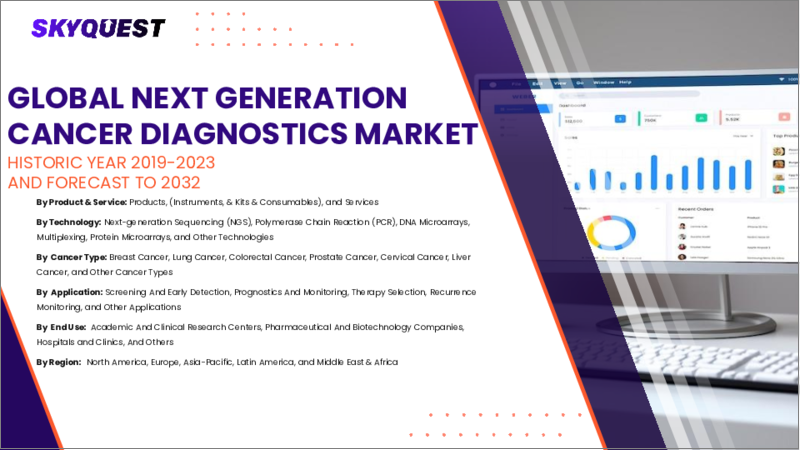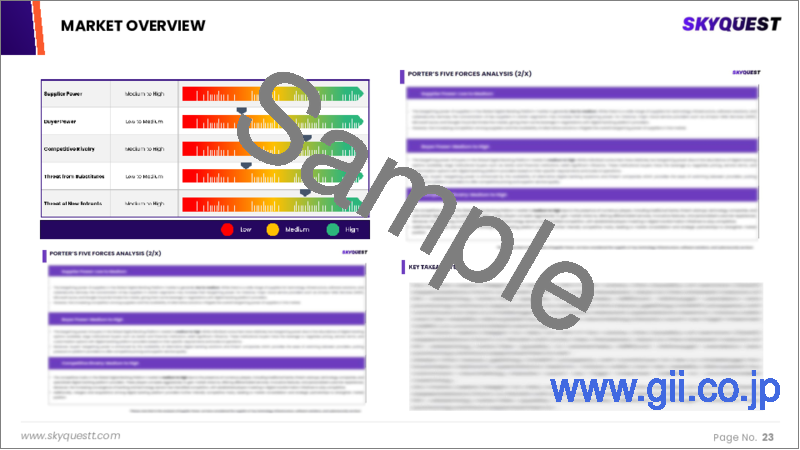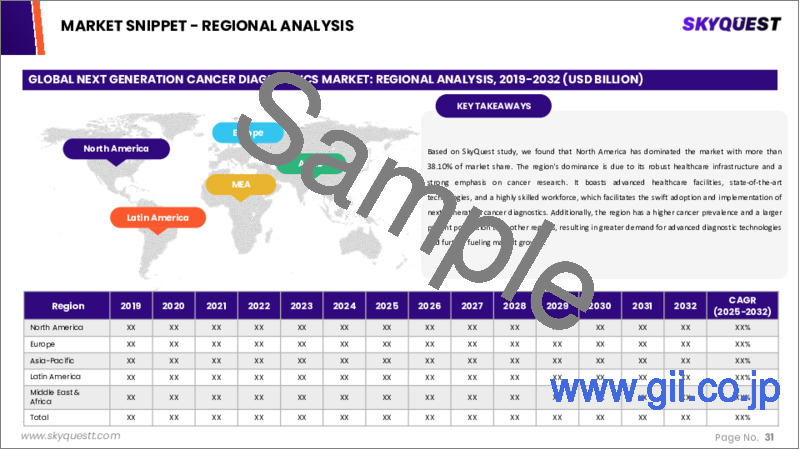|
|
市場調査レポート
商品コード
1554258
次世代がん診断の市場規模、シェア、成長分析:技術別、用途別、がんタイプ別、機能別、地域別 - 産業予測、2024年~2031年Next Generation Cancer Diagnostics Market Size, Share, Growth Analysis, By Technology, By Application, By Cancer Type, By Function, By Region - Industry Forecast 2024-2031 |
||||||
|
|||||||
| 次世代がん診断の市場規模、シェア、成長分析:技術別、用途別、がんタイプ別、機能別、地域別 - 産業予測、2024年~2031年 |
|
出版日: 2024年09月05日
発行: SkyQuest
ページ情報: 英文 219 Pages
納期: 3~5営業日
|
- 全表示
- 概要
- 目次
世界の次世代がん診断の市場規模は、2022年に116億米ドルとなり、予測期間(2024年~2031年)のCAGRは17.8%で、2023年の136億6,000万米ドルから、2031年までには430億2,000万米ドルに成長する見通しです。
次世代がん診断市場は、従来のラボ検査から迅速なポイントオブケア検査へのシフトによって大きく成長します。この移行は、先進的な診断機器、キット、試薬の商業化によって促進されると予想されます。市場は、個別化ゲノム医療を強化するコンパニオン診断の開拓から恩恵を受けると思われます。Global Cancer Observatory 2021によると、2020年の非ホジキンリンパ腫の症例数は54万4,000例以上、ホジキンリンパ腫の症例数は8万3,000例以上、白血病の症例数は47万4,000例、多発性骨髄腫の症例数は17万6,000例です。がんは世界第2位の死因であり、年間約960万人が死亡していることから、より効果的な診断ツールの開発が急務となっています。市場の拡大は、より早期かつ正確な疾患発見を可能にする新たながんバイオマーカーや検査の継続的な開拓によってさらに推進されています。毎年37万5,000人以上の新規症例が報告され、死亡率は44%を超えるという、がんの罹患率の増加と高い死亡率に対処するため、研究者たちは革新的で低侵襲な診断法の開発に注力しています。
目次
イントロダクション
- 調査の目的
- 定義
- 市場範囲
調査手法
- 情報調達
- 二次・一次情報源
- 市場規模予測
- 市場の前提条件と制限
エグゼクティブサマリー
- 市場概要見通し
- 供給需要動向分析
- セグメント別機会分析
市場力学と見通し
- 市場力学
- 促進要因
- 機会
- 抑制要因
- 課題
- ポーターの分析
主要な市場の考察
- 市場の主要な成功要因
- 競合の程度
- 主要な投資機会
- 市場魅力度指数
- エコシステムマッピング
- 技術分析
- サプライチェーン分析
- バリューチェーン分析
- パイプライン分析
次世代がん診断市場:技術別
- 市場概要
- 次世代シーケンシング
- qPCR・マルチプレックス
- ラボオンチップ(LOAC)・RT-PCR
- タンパク質マイクロアレイ
- DNAマイクロアレイ
次世代がん診断市場:用途別
- 市場概要
- バイオマーカー開発
- CTC分析
- プロテオーム解析
- エピジェネティック解析
- 遺伝子解析
次世代がん診断市場:がんタイプ別
- 市場概要
- 肺
- 胸
- 大腸
- 頸部
- その他
次世代がん診断市場:機能別
- 市場概要
- 治療モニタリング
- コンパニオン診断
- 予測
- がん検診
- リスク分析
次世代がん診断市場規模:地域別
- 市場概要
- 北米
- 米国
- カナダ
- 欧州
- ドイツ
- 英国
- フランス
- イタリア
- スペイン
- その他欧州地域
- アジア太平洋
- 中国
- インド
- 日本
- 韓国
- その他アジア太平洋
- ラテンアメリカ
- ブラジル
- その他ラテンアメリカ地域
- 中東・アフリカ(MEA)
- GCC諸国
- 南アフリカ
- その他中東・アフリカ地域
競合情勢
- 上位5社の比較
- 主要企業の市場ポジショニング、2023年
- 主要な市場企業が採用した戦略
- 市場における最近の活動
- 主要企業の市場シェア(%)、2023年
主要企業プロファイル
- Abbott Laboratories(US)
- Agilent Technologies, Inc.(US)
- Bio-Rad Laboratories, Inc.(US)
- Danaher Corporation(US)
- Exact Sciences Corporation(US)
- F. Hoffmann-La Roche Ltd.(Switzerland)
- GE Healthcare(US)
- Guardant Health, Inc.(US)
- Hologic, Inc.(US)
- Illumina, Inc.(US)
- Merck & Co., Inc.(US)
- Myriad Genetics, Inc.(US)
- NanoString Technologies, Inc.(US)
- Natera, Inc.(US)
- NeoGenomics, Inc.(US)
- Qiagen N.V.(Netherlands)
- Quest Diagnostics Incorporated(US)
- Siemens Healthineers AG(Germany)
- Sysmex Corporation(Japan)
- Thermo Fisher Scientific, Inc.(US)
- Veracyte, Inc.(US)
Global Next Generation Cancer Diagnostics Market size was valued at USD 11.60 Billion in 2022 and is poised to grow from USD 13.66 Billion in 2023 to USD 43.02 Billion by 2031, at a CAGR of 17.8% during the forecast period (2024-2031).
The Next Generation Cancer Diagnostics Market is set for substantial growth driven by the shift from traditional laboratory testing to rapid point-of-care testing. This transition is expected to be bolstered by the commercialization of advanced diagnostic devices, kits, and reagents. The market will benefit from the development of companion diagnostics, which enhance personalized genomic medicine. According to the Global Cancer Observatory 2021, there were over 544,000 cases of non-Hodgkin lymphoma and 83,000 cases of Hodgkin lymphoma in 2020, along with 474,000 cases of leukemia and 176,000 instances of multiple myeloma. With cancer being the second leading cause of death worldwide, resulting in approximately 9.6 million deaths annually, there is an urgent need for more effective diagnostic tools. The market's expansion is further driven by the continuous development of new cancer biomarkers and tests, enabling earlier and more accurate disease detection. Researchers are focused on creating innovative, minimally invasive diagnostic methods to address the increasing incidence and high mortality rate of cancer, with over 375,000 new cases reported each year and a mortality rate exceeding 44%.
Top-down and bottom-up approaches were used to estimate and validate the size of the Global Next Generation Cancer Diagnostics market and to estimate the size of various other dependent submarkets. The research methodology used to estimate the market size includes the following details: The key players in the market were identified through secondary research, and their market shares in the respective regions were determined through primary and secondary research. This entire procedure includes the study of the annual and financial reports of the top market players and extensive interviews for key insights from industry leaders such as CEOs, VPs, directors, and marketing executives. All percentage shares split, and breakdowns were determined using secondary sources and verified through Primary sources. All possible parameters that affect the markets covered in this research study have been accounted for, viewed in extensive detail, verified through primary research, and analyzed to get the final quantitative and qualitative data.
Global Next Generation Cancer Diagnostics Market Segmental Analysis
Global Next Generation Cancer Diagnostics Market is segmented on the basis of technology, application, cancer type, function, and region. By technology, the market is segmented into next-generation sequencing, qPCR & multiplexing, lab-on-a-chip (LOAC) & RT-PCR, protein microarrays, and DNA microarrays. By application, the market is segmented into biomarker development, CTC analysis, proteomic analysis, epigenetic analysis, and genetic analysis. By cancer type, the market is segmented into lung, breast, colorectal, cervical, and others. By function, the market is segmented into therapeutic monitoring, companion diagnostics, prognostics, cancer screening, and risk analysis. By region, the market is segmented into North America, Europe, Asia Pacific, Middle East & Africa, and Latin America.
Drivers of the Global Next Generation Cancer Diagnostics Market
The growing demand for personalized medicine is significantly driving the next generation cancer diagnostics market. Personalized medicine focuses on tailoring treatments based on individual genetic profiles and other unique characteristics, and advanced diagnostic tools are essential for identifying patients who will benefit most from these customized therapies. Additionally, increasing awareness about the importance of early cancer detection is further fueling market growth. Early detection improves treatment outcomes and survival rates, and next generation diagnostic tools are pivotal in facilitating early cancer detection and enhancing screening programs.
Restraints in the Global Next Generation Cancer Diagnostics Market
Reimbursement issues pose a significant restraint on the Next Generation Cancer Diagnostics Market due to the current lack of clear and standardized reimbursement policies. The slow development of these policies complicates the adoption and utilization of advanced diagnostic technologies, as both healthcare providers and patients struggle to justify the associated costs. Discrepancies in reimbursement policies across different countries, regions, and healthcare systems, coupled with ongoing policy development and a lack of consensus, further hinder the market's growth and adoption.
Market Trends of the Global Next Generation Cancer Diagnostics Market
In the Next Generation Cancer Diagnostics Market, liquid biopsy tests are gaining traction as a groundbreaking alternative to traditional tissue biopsies. These tests, which analyze blood, urine, or other bodily fluids to detect cancer cells and biomarkers, offer a less invasive and more cost-effective method for cancer diagnosis and monitoring. The enhanced frequency and accuracy of results provided by liquid biopsies have spurred increased adoption, with numerous companies actively investing in their development and integration into clinical practice.
Table of Contents
Introduction
- Objectives of the Study
- Definitions
- Market Scope
Research Methodology
- Information Procurement
- Secondary & Primary Data Sources
- Market Size Estimation
- Market Assumptions & Limitations
Executive Summary
- Market Overview Outlook
- Supply Demand Trend Analysis
- Segmental Opportunity Analysis
Market Dynamics & Outlook
- Market Dynamics
- Drivers
- Opportunities
- Restraints
- Challenges
- Porters Analysis
- Competitive rivalry
- Threat of Substitute Products
- Bargaining Power of Buyers
- Threat of New Entrants
- Bargaining Power of Suppliers
Key Market Insights
- Key Success Factors of The Market
- Degree Of Competition
- Top Investment Pockets
- Market Attractive Index
- Ecosystem Mapping
- Technology Analysis
- Supply Chain Analysis
- Value Chain Analysis
- Pipeline Analysis
Global Next Generation Cancer Diagnostics Market by Technology
- Market Overview
- Next-generation Sequencing
- qPCR & Multiplexing
- Lab-on-a-chip (LOAC) & RT-PCR
- Protein Microarrays
- DNA Microarrays
Global Next Generation Cancer Diagnostics Market by Application
- Market Overview
- Biomarker Development
- CTC Analysis
- Proteomic Analysis
- Epigenetic Analysis
- Genetic Analysis
Global Next Generation Cancer Diagnostics Market By Cancer Type
- Market Overview
- Lung
- Breast
- Colorectal
- Cervical
- Others
Global Next Generation Cancer Diagnostics Market By Function
- Market Overview
- Therapeutic Monitoring
- Companion Diagnostics
- Prognostics
- Cancer Screening
- Risk Analysis
Global Next Generation Cancer Diagnostics Market Size By Region
- Market Overview
- North America
- USA
- Canada
- Europe
- Germany
- UK
- France
- Italy
- Spain
- Rest of Europe
- Asia Pacific
- China
- India
- Japan
- South Korea
- Rest of Asia-Pacific
- Latin America
- Brazil
- Rest of Latin America
- Middle East & Africa (MEA)
- GCC Countries
- South Africa
- Rest of MEA
Competitive Landscape
- Top 5 Player Comparison
- Market Positioning of Key Players, 2023
- Strategies Adopted by Key Market Players
- Recent Activities in the Market
- Key Companies Market Share (%), 2023
Key Company Profiles
- Abbott Laboratories (US)
- Company Overview
- Business Segment Overview
- Financial Updates
- Key Developments
- Agilent Technologies, Inc. (US)
- Company Overview
- Business Segment Overview
- Financial Updates
- Key Developments
- Bio-Rad Laboratories, Inc. (US)
- Company Overview
- Business Segment Overview
- Financial Updates
- Key Developments
- Danaher Corporation (US)
- Company Overview
- Business Segment Overview
- Financial Updates
- Key Developments
- Exact Sciences Corporation (US)
- Company Overview
- Business Segment Overview
- Financial Updates
- Key Developments
- F. Hoffmann-La Roche Ltd. (Switzerland)
- Company Overview
- Business Segment Overview
- Financial Updates
- Key Developments
- GE Healthcare (US)
- Company Overview
- Business Segment Overview
- Financial Updates
- Key Developments
- Guardant Health, Inc. (US)
- Company Overview
- Business Segment Overview
- Financial Updates
- Key Developments
- Hologic, Inc. (US)
- Company Overview
- Business Segment Overview
- Financial Updates
- Key Developments
- Illumina, Inc. (US)
- Company Overview
- Business Segment Overview
- Financial Updates
- Key Developments
- Merck & Co., Inc. (US)
- Company Overview
- Business Segment Overview
- Financial Updates
- Key Developments
- Myriad Genetics, Inc. (US)
- Company Overview
- Business Segment Overview
- Financial Updates
- Key Developments
- NanoString Technologies, Inc. (US)
- Company Overview
- Business Segment Overview
- Financial Updates
- Key Developments
- Natera, Inc. (US)
- Company Overview
- Business Segment Overview
- Financial Updates
- Key Developments
- NeoGenomics, Inc. (US)
- Company Overview
- Business Segment Overview
- Financial Updates
- Key Developments
- Qiagen N.V. (Netherlands)
- Company Overview
- Business Segment Overview
- Financial Updates
- Key Developments
- Quest Diagnostics Incorporated (US)
- Company Overview
- Business Segment Overview
- Financial Updates
- Key Developments
- Siemens Healthineers AG (Germany)
- Company Overview
- Business Segment Overview
- Financial Updates
- Key Developments
- Sysmex Corporation (Japan)
- Company Overview
- Business Segment Overview
- Financial Updates
- Key Developments
- Thermo Fisher Scientific, Inc. (US)
- Company Overview
- Business Segment Overview
- Financial Updates
- Key Developments
- Veracyte, Inc. (US)
- Company Overview
- Business Segment Overview
- Financial Updates
- Key Developments





